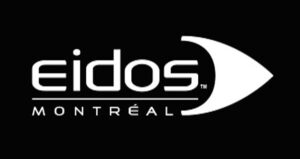Our group’s expedition into the hallowed cloisters of Eidos Montreal began with the unassuming. We were led into a generic cement-and-steel office structure, and then up a bank of elevators.
Once the doors opened, the group was treated to its first view of the studio: a well-lit reception area plastered with the collective’s awards and accolades, action figures of Adam Jensen and his adversaries, and a replica of Jensen’s cybernetic arm under a glass case. As we waited for our guide into the facilities, a man in a Hawaiian shirt and shorts sauntered out of an elevator, brandishing a box of Honey Bunches of Oats and a carton of milk. This scene set the tone for the rest of our visit, the casual atmosphere being immediately apparent from both the man’s choice of dress and his choice of breakfast grains.
Shortly after the jaunty incarnation of Ceres made his visitation, our guide arrived, and he led us through the workings of Eidos, starting with Human Resources. True to my expectations, it was identical to the HR sections of every other company I had ever seen, but boasted chibi Hitman headphone stands for each employee, which undoubtedly increased productivity in a manner invisible to us laypeople. Next was the QA holding pen, where a variety of well-caffeinated personalities either reclined on couches or sat at cubicles, playing games yet unreleased to the public and eating snacks out of a nearby vending machine. After the pleasure pits of the QA sector came development, where we witnessed the creative and structural backbone of the company slaving away on Visual Studio and Maya, some scribbling with wild abandon on large whiteboards. We would later learn that instead of sequestering its programming and art sections into different departments, Eidos believes that close proximity facilitates communication, and creates a more cohesive end-product. The extensive development sector came to an end, and we were denied access to the motion-capture facility, as there was a project underway. Our tour ended at the cafeteria, which contained more vending machines, water coolers, and plastic crates presumably full of military-grade vat-grown biofeed, engineered to heighten coding potential and grant the ability to manipulate vertices with an errant thought.
Our final destination was a presentation room, a name unbefitting of the veritable theater it was, complete with plush pull-down seats and a surround sound system. We were shown several trailers for games the studio had made, then a brief presentation that outlined the company’s history, workforce constituents, and employee benefits. The group’s inquisitions were sated in the final segment of our visit, which had the guide answering a gauntlet of questions about engine viability, what HR looks for on resumes, and many others. Of these, the answers that most interested me concerned the role of the designer. While prototyping is an ability the company values, it seems that the designer is routinely paired with a programmer to realize whatever prototyping task is at hand, and so there is less emphasis on the designer writing code, the fact being that a programmer is generally better at programming than most designers. This is not to say that Eidos doesn’t value employees who are capable of a variety of different tasks; designers are still the paragons of communication across the team, and ideas are constantly conveyed through daily Scrum meetings. It helps the entire team to have members who have at least a vague idea of what their compatriots’ work entails, and HR does value the prospective employee with a broader range of skills higher.
As we were escorted from the building, it dawned on me that the life of a AAA studio employee is one I can stand living. My preconceptions about the AAA industry were built around the notion of compartmentalization, that one’s ideas would never be as important or personal as those on a smaller project, due to the game being an amalgam of the work of many. This view neglects the fact that each member of the team is tasked with creating a part of a cohesive experience that resonates positively with all other parts, and that no one
element of the end-product is unimportant. At the end of the day, I too would like to share in the peaceful joy of the man strolling into his office with Honey Bunches of Oats.
– Wei-Hung Chen, Game Design Major, Fall 2014

